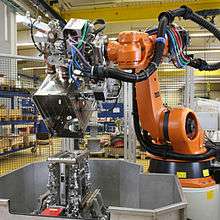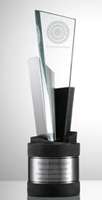KUKA Systems
|
| |
| GmbH (company with limited liability) | |
| Industry | Machine systems and plant engineering, automation technology |
| Founded | 1898 / 1996 / 2007 |
| Founder | Johann Josef Keller and Jakob Knappich |
| Headquarters | Augsburg, Germany |
| Products | Plant engineering, special purpose machine manufacturing, automotive, automation technology, joining technology, engineering, photovoltaic industry, aviation parts, equipment manufacturing, press automation, forming technology, welding technology, control systems |
| Revenue |
KUKA Systems (global)
|
Number of employees |
KUKA Systems (worldwide):
|
| Parent | KUKA |
| Website | www.kuka-systems.com |
KUKA Systems GmbH, a division of KUKA Aktiengesellschaft, Augsburg, is an international supplier of engineering services and flexible automated manufacturing solutions with around 3,900 employees in twelve countries globally. [1]
KUKA Systems’ plants/equipments are being used by various automotive manufacturers such as BMW, GM, Chrysler, Ford, Volvo, Volkswagen, Daimler AG as well as manufacturers from other industrial sectors such as Airbus, Astrium, Siemens, BSH (Bosch und Siemens Hausgeräte GmbH) and many more. The range includes products and services for virtually all tasks in the industrial processing of metallic and non-metallic materials for various industries (i.e., automotive, energy, aerospace, rail vehicles, agricultural machinery…). [2]
History
In 1898, the acetylene factory, Augsburg was founded by Johann Josef Keller and Jakob Knappich for the production of low-cost domestic and municipal lighting, household appliances and automobile headlights. In 1905, the production was extended to the innovative autogenous welding equipments. After the First World War, Keller and Knappich resumed production of safety-, manual- and power-winches and began the manufacturing of large vessels. As a result, the Bayerische Kesselwagen GmbH was formed in 1922. The Bayerische Kesselwagen GmbH was responsible for the development and production of superstructures for municipal vehicles (street cleaning machines, sewage trucks, garbage trucks). In 1927, this business division presented the first large garbage truck. The name KUKA came into being in the same year through the company’s name at that time “Keller und Knappich Augsburg”.
The development and manufacture of spot welding equipments began in 1936. Three years later, KUKA already had more than 1,000 employees. After the major destruction of the company during the Second World War in 1945, KUKA started manufacturing welding machines and other small appliances again. With new products such as the double-cylinder circular knitting machine and the portable typewriter "Princess", KUKA introduced new industrial fields and gained independence from the supply sector. In 1956, KUKA manufactured the first automatic welding system for refrigerators & washing machines and supplied the first multi-spot welding line to Volkswagen AG. Ten years later, the first friction welding machine went into production. In 1967, the arc welding method was applied for the first time at KUKA. In 1971, the delivery of the first robotic welding system for the S-Class took place. A year later, the magnetic arc-welding machine came to the market.
With the production of the robot “Famulus” in 1973, KUKA succeeded in entering the robot production. In 1978, beginning with the IR 601/60, robot production went into mass-production. In 1981, KUKA’s main activities were grouped into three independent companies: the KUKA Schweissanlagen und Roboter GmbH, the KUKA Umwelttechnik GmbH and the KUKA Wehrtechnik GmbH, which was re-sold to Rheinmetall in 1999. Towards the end of 1982, the LSW Maschinenfabrik GmbH, Bremen became a subsidiary of KUKA. In 1993, the first laser-roof-seam welding systems were manufactured. These welding systems were then further expanded to adhesive bonding and sealing technologies in the following year. Around the same time, KUKA took over the tools & equipment manufacturers, Schwarzenberg GmbH, and expanded its business to China and the USA in the following years.
In 1996, KUKA Schweissanlagen GmbH became an independent company and two years later, the market leader among European welding equipment manufacturers. The supply of the first pressing tools for automobile side-walls made of high-strength steel began in 2002. The company launched the KUKA RoboScan with remote laser welding head in 2003. Since 2006, KUKA Systems is operating its own bodyshell factory in Toledo, America and produces the bodywork for the Jeep Wrangler by Chrysler.
In the course of internationalization and expansion of business units and technologies such as reshaping, tooling, bonding, sealing, etc., KUKA Schweissanlagen GmbH became KUKA Systems GmbH in 2007. In 2010, KUKA presented a newly developed standardized cell concept for welding solutions, KUKA flexibleCUBE.
In the automation sector, KUKA Systems offers standard and customized solutions for industrial production automation; joining technologies and component handling are amongst their activity. The technologies are tested and the production processes are fully optimized prior to the development. In addition, KUKA Systems offers engineering and individual counseling, so that customized/special production solutions can be planned and optimized in co-operation with the customer.
Fields of application
Aerospace

KUKA Systems supplied the TIG welding cell for the upper stage of the Ariane 5 launcher-rocket.
TIG welding stands for tungsten inert gas welding and is a special form of arc welding and is one
of the core activities of KUKA Systems. The company also provides apparatuses appliances for the construction of aircraft structural elements.
Boeing, Bell and Airbus are among KUKA Systems' respective customers.
Automotive

The KUKA Systems portfolio includes the spectrum of production automation of joining and assembling of vehicle body structures:
from low-scale automated production facilities to highly flexible manufacturing systems; from production of individual equipments
or subassemblies to the assembly of complete body structures and mechanical parts. Equipments for assembling discs and mounting
systems for vehicle bodies and chassis (so-called “marriage”) or component installation are also available.
BMW, GM, Chrysler, Ford, Volvo, Volkswagen and Daimler AG are among the customers in this business sector.
Production of rail vahicles

Manufacturers of rail vehicles are also among the customers of KUKA Systems e.g., for the construction of locomotives,
subway wagons or in setting up of innovative and highly automated production lines for freight wagons.
Production of photovoltaic modules

KUKA Systems offers solutions for every step of the photovoltaic module production - from brick-sawing
to cell handling and cross-tie soldering to framing and packaging of modules
Welding technology – General

KUKA Systems represents itself in various other industrial sectors as well. A few examples out of many
are the production of baby strollers or the production of white goods for BSH (Bosch und Siemens Hausgeräte GmbH)
Awards and certificates


Certificates
Gallery
 1898 Company founded by Johann Josef Keller and Jacob Knappich
1898 Company founded by Johann Josef Keller and Jacob Knappich 1949 an Augsburg Princess
1949 an Augsburg Princess 1920 Success in large container construction
1920 Success in large container construction 1931 Resistance Welding
1931 Resistance Welding 1934 KdF Wagen
1934 KdF Wagen 1955 Large container manufacture
1955 Large container manufacture 1965 German-American tank program at KUKA
1965 German-American tank program at KUKA 1972 Construction of the first Magnet-arc welding machine
1972 Construction of the first Magnet-arc welding machine 1974 Seam welding
1974 Seam welding
References
- ↑ "KUKA Systems worldwide".
- ↑ "KUKA Systems delivers to new Volkswagen plant". Retrieved 2010-04-23.
- ↑ "Company history located on the KUKA Systems Homepage". Retrieved 2010-04-21.
- ↑ "Quality around the clock". Retrieved 2010-04-27.
External links
| Wikimedia Commons has media related to KUKA. |
